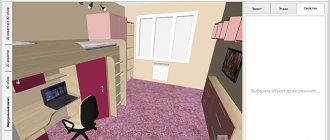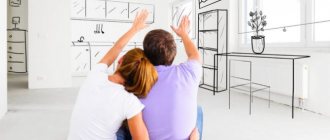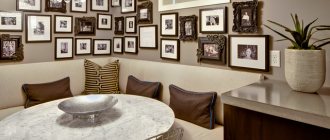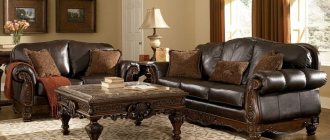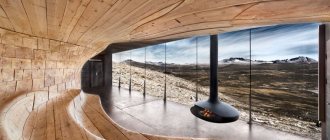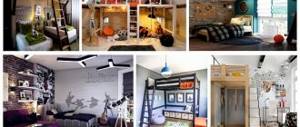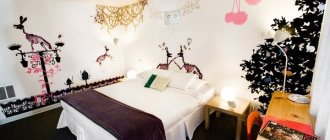Batteries
Heating radiators, in principle, are not the most aesthetic element of the interior, especially such massive ones as cast-iron Soviet radiators. And yet, do not rush to get rid of them or hide them in shame. If these heating elements are in good condition, breathe new life into them with a simple paint job: to match the walls, curtains, or in a bright, contrasting color. White, black, and gray batteries are a good solution for loft and minimalism styles, and colored options are a way to create an accent against the background of neutral walls. In a children's room, old-style radiators can be turned into colored pencils.
Russian style. Interior and life in the first decades of the USSR
Along with such popular interior styles as baroque, modern, and country, you can put the Russian style, which corresponds to the era of the USSR. Designers often refer to Soviet interior style with the pretentious word “kitsch,” which literally means “a carbon-stamped object of low-quality production.” The beginning of the formation of such a furnishing of premises began in the 20s of the twentieth century and has not yet ended for one simple reason: people who were born and lived most of their lives in a union cannot accept changes and furnish their home (refrain from alterations), imitating culture of the times of Brezhnev and Khrushchev.
Parquet
If you are lucky enough to live in an apartment with herringbone parquet flooring, try to preserve it and not replace it with a fashionable laminate. Firstly, removing old parquet and laying out new, high-quality flooring is simply expensive. Secondly, such parquet is very durable: bring it back to life by sanding and applying varnish, and it will last for several more decades. And thirdly, if you are a fan of the Scandinavian style, you must remember: the ideal covering in this case is wooden floors or parquet.
Soviet chic: 66 m² apartment in Moscow
“This apartment has a complex character, almost Bulgakov’s.
When designing it, the client and I did not strive to follow any particular style and allowed ourselves a little irony,” says designer Alena Skovorodnikova Type of property: apartment in a Stalinist building
Area: 66 m²
Place: Moscow, Kutuzovsky Prospekt
Style: vintage eclectic
The main idea of the project: to preserve the charm of an old Soviet apartment and create a feeling of a lived-in interior
Color range: natural shades of wood, blue, ocher, olive and deep burgundy
Project author: Alena Skovorodnikova, www.skovorodnikova.ru, +7 (916) 321 9336
“The apartment has a complex character, it was very resistant to our intervention,” says designer Alena Skovorodnikova. — There is not a single item or finishing element that arrived, was installed and took root the first time. At first it was funny, then it was alarming, but in the end everyone came to terms with it. It’s not for nothing that the house has such a dubious reputation: the building was built on a Jewish cemetery, and on the forum of the house there is sometimes talk about witches. But all’s well that ends well, the customer is very pleased with the implementation and feels great in this apartment.”
“The typical Stalinist layout - a long corridor along which there is a walled-up auditory corridor from the neighboring entrance, two rooms, a small kitchen, a separate bathroom - was not changed in order to preserve the historical parquet and stucco. But by removing layers of drywall left over from renovations in the 90s, the area of the premises increased slightly.”
“The parquet, stucco, doors and cast-iron radiators were preserved and restored at the customer’s request. Only the windows and plumbing were replaced. Soviet ceramic tiles were originally laid behind the cast-iron radiators; they were dismantled, but the idea itself was preserved, choosing more “survived” embossed ceramic tiles. In the double door of the living room, the old glass was replaced with stained glass, inspired by the stained glass in antique shop windows. Spectacular Metlakh “carpets” were laid out in the wet areas, and in the kitchen we took liberties in the form of multi-colored ceramic scales.”
“The owner wanted the walls to be weathered, faded and picturesque - like in the Italian provinces”
“The owner wanted the walls to be a backdrop for vintage furniture, but at the same time self-sufficient and as if weathered, faded - like in the Italian province. The first stage - applying chips, unevenness and abrasions and painting in pre-approved shades - was carried out by the builders. Then professional decorators aged the surface as much as possible and brought it to the desired appearance, with stains, stains and even smudges.”
The main accent of the bedroom interior is the headboard, formed by a bright red carpet in the best traditions of Soviet apartments
“Vintage items were selected from various European suppliers. Particularly interesting are the antique Chinese screen with inlay in the bedroom and the European showcases with stained glass in the living room. The client had a wardrobe in the bedroom, a piano and a desk before the renovation, but they were carefully restored. The bedroom interior was diluted with oriental notes. This is how mahogany, carved bedside tables and a chinoiserie screen arose. But the main accent is the bright red carpet on the wall in the best traditions of Soviet apartments!”
“At the final stage of decorating the interior of the apartment, as is usually the case, various suppliers and contractors began to come in frequently. And everyone wondered how it could be, why you didn’t finish the renovation, why you left such walls, and did you really do anything here at all? For us, this was the main compliment and proof that the atmosphere of an old and lived-in apartment turned out to be truly convincing!” www.skovorodnikova.ru
Hirst Shkulev Publishing
Moscow, st. Shabolovka, building 31b, 6th entrance (entrance from Konny Lane)
www.elledecoration.ru
Wooden frames
Yes, plastic windows retain heat better and do not need to be insulated for the winter. That is why they are massively replacing wooden window frames. And yet, wood is at least environmentally friendly and aesthetically pleasing, and it looks much cozier and warmer than plastic. Such frames probably require restoration, but they are worth it.
If you are determined to replace wood with plastic, do not throw away the old frames. Options divided into sections can be used as photo frames.
Wall
The main advantage of this large-sized group of cabinets is spaciousness, and the disadvantage, closely related to this, is massiveness. Critics of Soviet interiors claim that the wall occupied almost a third of the usable area of the room, and this was often true. The Soviet wall can continue to be used for its intended purpose - as a storage system, by modifying it. Decide what you want to get and make a drawing. If you replace the doors and remove the extra shelves, you will get a spacious wardrobe. You can do the opposite: remove the doors and add new shelves - a shelving unit for your home library is ready. You will have to spend time and money updating the old wall (restoration, installation work, replacing shelves and doors), but you will get truly exclusive furniture.
Soviet interior or “grandmother’s version”
Realtors came up with their own term for Soviet interior design – “grandmother’s version.” These apartments are renovated from the 80s-90s, and sometimes from the 70s. The furniture in such a home, as a rule, is already faded and has a pitiful appearance; it belongs in the country house. The main feature of the “grandmother’s version” of apartments is herringbone parquet in brown shades and the same type of tasteless patterned faded wallpaper.
Round table
The family gathered behind it in the kitchen, and if it was extendable, then on holidays it was moved to a large room where guests were received. Such a table always turned out to be more spacious than a square one: due to the lack of corners, more chairs could be placed around it. Polish its surface, which probably has scratches and marks from hot cups, and return the table to the kitchen. It’s worth doing this if only because of the intimate atmosphere it creates. Sitting at a round table, you see everyone else at once, not just those opposite you.
It doesn't clutter up the space
Furniture of the 60s was made for standard apartments with two-meter ceilings and narrow doors. Therefore it is compact and low. Even tables and chair seats at that time began to be made a couple of centimeters lower, so that there was more free space above them. For the same reason, chairs from the 60s have lattice backs, and you can stick your hand under the armrest of the chair. The furniture was made in such a way as to create minimal obstacles to the view: looking over it and through it, a person clearly sees the boundaries of the room. This is also helped by the high legs on which all the objects of that era stand: the floor is visible underneath them.
Sewing machine with cast iron bed
Several brands of sewing machines were produced in the USSR, but the ultimate dream of Soviet needlewomen was still foreign options: Singer, Pfaff or Husqvarna. And today, some houses still have old models of these machines, produced with a cast iron frame. Some consider them priceless antiques, while others consider them a dust collector that wastes space in the pantry or on the balcony. The car should be left at least as a family heirloom, and the deceptively airy and light-looking frame should be given a second life, turning it into the basis for new furniture. Paint or polish the cast iron parts of the frame and replace the table top and you have a new table that can be used as a vanity. At the bottom of the frame, where the pedal is located, you can arrange a shelf for books or boxes with threads and corners.
Watch
Today, to find out the time, you do not need a separate device, so clocks in the interior serve only a decorative function. A grandfather clock in a wooden case belongs in a spacious room with high ceilings, decorated in a classic style. A cuckoo wall clock is a good addition to a country style kitchen. And place stylish timeless table clocks, “Lightning”, “Rocket”, “Glory”, “East” on the bedside table or on the chest of drawers, next to the books.
Main features
To highlight and appreciate the features of the Soviet interior, you can carefully look at old family photos. There was not much variety in those days: the same type of furniture, factory-made decorative items, and almost identical materials were sold. Despite this, many created unique designs on their own. Housewives sewed curtains, embroidered tablecloths, grandmothers wove rugs, men did carpentry and wood carving.
Furniture required included lacquered tables and bedside tables, and extendable sofas. Children's rooms have always been complemented by shelves for books, massive tables with drawers for storing school supplies. The living room always had blown chairs upholstered in bright velvet.
If you plan to recreate the Soviet atmosphere in the interior of your home, use only natural finishing materials. Wooden floors will be a good alternative to the usual linoleum (in extreme cases, you can lay parquet).
Furniture will have to be made to order. However, in the attic or in the country house you may find old chairs, a trellis, or a desk. They can be restored and used in the interior.
Suitcases
In Soviet times, suitcases also acted as interior items: outside of trips, they were used to store out-of-season items or something important for the owner - for example, old magazines or letters. Today it is unlikely that Soviet suitcases will be used for their intended purpose: they have neither wheels nor telescopic handles. But you can turn them into something new. A fairly rigid suitcase is the basis for a bedside table: all that remains is to attach legs to it or place it on a stool. You can put several different suitcases on top of each other, playing with textures and colors.
Separate the lid from the suitcase and place a pillow of the same size in the remaining part - a bed for a cat or small dog is ready.
Russian style. Interior and life in the USSR
Communal apartments
The history of communal apartments began at the moment when the Soviet government came up with the idea of moving the proletariat into large multi-room apartments of the middle class of pre-revolutionary Russia. In the first years of its existence, the Soviet government, which promised to give workers factories, became convinced that it was not able to provide them with even separate housing. The problem became especially urgent in large cities, whose population was growing rapidly.
The Bolsheviks, with their characteristic penchant for simple solutions, found a way out - they began to move several families into one apartment, allocating each a separate room with a common kitchen and bathroom. This is how the process of creating communal apartments was launched. Completely different people, often entire families, moved into the apartment, which consisted of several rooms. Accordingly, they had one room and a common kitchen and bathroom.
Neighbors in communal apartments - people of different social status, life interests and habits - lived in one place, intertwined destinies, quarreled and made peace. “Relationships between residents of communal apartments, as a rule, were tense: everyday difficulties embittered people,” writes writer Lev Stern in his memoirs about Odessa. “If you sometimes have to wait in line for a long time to use the toilet or tap, it is difficult to expect warm relationships between neighbors.”
As a rule, communal apartments were organized in apartment buildings - multi-story buildings built by the Tsars, erected by the beginning of the 20th century in large cities. The communists began to densify the population of these “bourgeois” nests as soon as they established control over the cities. “It is necessary to densify housing, and in view of the lack of housing, we will resort to the eviction of those elements whose stay is not necessary,” wrote the newspaper Kiev Communist on February 19, 1919, two weeks after the Bolsheviks’ second attempt to gain a foothold in Kyiv. On behalf of the new government, the newspapers informed readers that “loafers, speculators, criminals, White Guards, etc. elements, of course, should be deprived of their apartments.” In addition, in Soviet apartments, as it turned out, there should be no living rooms, halls and dining rooms. The Bolsheviks promised to leave offices only to those who needed them for work - doctors, professors and senior officials. As a rule, one or two floors were vacated for new management. Previous residents and owners were placed in the same buildings, offering to vacate the square meters allocated for government needs within 24 hours. You were only allowed to take your bed and essentials with you.
The painting “Housewarming Party” (1918) by K. S. Petrov-Vodkin is indicative:
It shows in some detail the clash between the old aristocratic way of life and representatives of the working people who moved to an unconventional home, the new masters of life. A large hall with a parquet floor, on which the new residents have laid out rustic paths, next to a huge mirror and oil paintings in gilded frames hung on the walls, there are stools mixed with carved chairs. Everyday objects of opposite social strata conduct their own silent dialogue, echoing the realities of social life.
Literally a couple of years after the former tenement buildings received new residents - small-town proletarians who flocked en masse to large cities after the revolution, the authorities were faced with an unexpected problem: strong-looking housing, built of stone and brick, began to quickly deteriorate. The poor who found themselves in the “manorial mansions” did not value them too much, because many new tenants not only received housing for free, but were initially exempt from paying rent. The “proletariat” quickly finished off the sewers, water supply and stoves. Garbage began to accumulate in the courtyards, which no one took out. And devastation came, just like according to Bulgakov.
The fact that the apartment was communal was clear from the threshold - near the front door there were several call buttons with the names of the heads of families and an indication of how many times to whom to call. In all common areas - hallway, kitchen, bathroom, toilet - there were also several light bulbs, according to the number of families (no one wanted to pay for the electricity used by a neighbor). And in the toilet, each had its own toilet seat, hanging right there on the wall. Common areas were cleaned on schedule. However, the concept of cleanliness was relative, because each user had his own idea about it. As a result, fungus and insects have become constant companions of communal apartments.
Paper products
Certificates of honor with Lenin's profile, old geographical maps, movie posters, filled pages from a stamp album are not waste paper, but a potential source of decorative items. Frame them in passe-partout, frame them and hang them on the wall instead of paintings and photographs. Perhaps there is a roll of wallpaper lying around on the mezzanine with a nostalgic and not even faded print? A fragment of wallpaper will also look good in a frame if you place it on a plain wall. Just like illustrations from your favorite books: it’s better not to remove them from the binding, but to scan and print them in high resolution.
Few people would think of recreating a Soviet interior down to the last detail, with all its asceticism and, in some places, bad taste. And yet, many of us value objects and signs of Soviet life, because they remind us of childhood. Don’t rush to get rid of them: made most often “to last,” they can not only decorate your home, but also last for a very long time.
Photo: Shutterstock; VIRGINIABLOGGERS.COM; recyclart.org; wonderfuldiy.com
Soviet design of a modern apartment
Soviet design is easily recognizable by its massive sideboards with crystal and dinnerware. Most of the apartments of Soviet citizens were filled with carpets, books and lacquered furniture. In photos of Soviet rooms you can often see embroidered tablecloths, napkins and even curtains.
People who lived most of their lives in the USSR were accustomed to storing for a long time even those things that had not been used for decades, so the rooms were often cluttered. However, modern design has adopted from the Soviet interior only those features that help make the atmosphere of the house unusual and comfortable.
- The design in the spirit of Soviet times is emphasized by massive furniture sets and upholstered furniture. From the lighting sources, it is best to choose a lamp on a leg with a massive lampshade.
- The Soviet style in apartment interiors can be emphasized through the use of wallpaper with a pattern characteristic of that time.
- You can hang carpets with multi-colored rhombuses on the walls of your apartments.
- In the kitchen you can use painted stools and wooden shelves for dishes.
- In Soviet times, the apartment was often decorated with hand-painted paintings and embroidered covers for armchairs and sofas. There were almost always embroidered napkins on the tables and sideboards. All this can still be used today.

